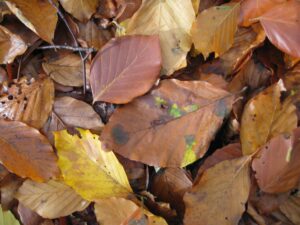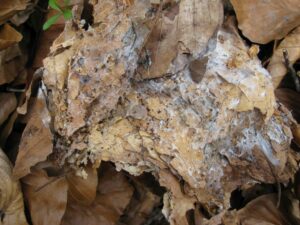Ol
O horizon, consists almost exclusively of undecomposed or poorly decomposed dead plant biomass, partly dotted, mottled, browned, wavy, weakly cracked, pitted and notched [l from litter]
- organic carbon content ≥ 15 mass % and
- developed under aeromorphic to aero-hydromorphic conditions
- Proportion of organic fine matter < 10 vol.%
Subdivision of Ol horizon
Ol horizont, leaf material common beech (Fagus sylvatica),
© Gerhard Milbert
Of
O horizon consisting of dead plant biomass, more decomposed than in the Ol horizon. Remains of sprout, leaf and needle are crushed, skeletonised, fragmented to rudimentary, mostly bleached or greyish. Packing of the leaf litter: loose, glued together or stacked. Packing of the needle litter: loose, attached to felted. Organic fine matter is clearly recognisable.
[f from fragmented]
- organic carbon content ≥ 15 mass % and
- developed under aeromorphic to aero-hydromorphic conditions
- Proportion of organic fine matter 10 – < 70 vol.%
(->F Mull)
Subdivision of Of horizon
Oh
O horizon with dominating organic fine matter and only a small proportion of macroscopically recognisable remains of dead plant biomass/litter.
[h from humified]
- organic carbon content ≥ 15 mass % and
- developed under aeromorphic to aero-hydromorphic conditions
- Proportion of organic fine matter ≥ 70 vol.%,
Subdivision of Oh-horizons


